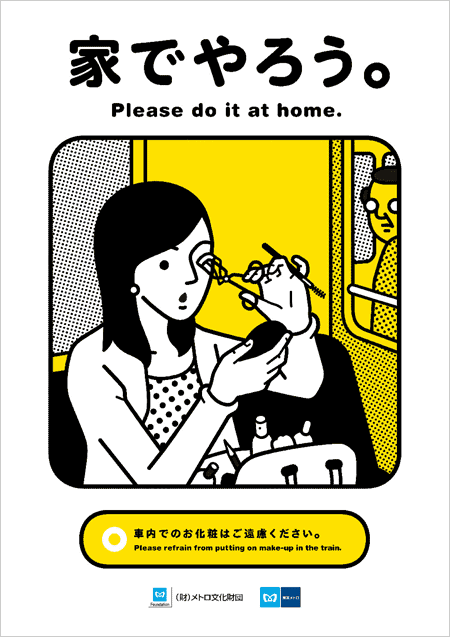Tokyo Metro produce refresh their series of subway posters annually, with an unique design for each month. In recent years, the posters by graphic artist Bunpei Yorifuji have been particularly stylish and easy to understand, utilising clever visuals and bright colours to grab the attention of commuters.
For the learner of Japanese, these posters are especially good as they offer simple sentences with matching pictures to effectively deliver the message. Even beginners can follow the messages! If that isn’t enough, matching English (with correct grammar, I might add) is presented alongside the Japanese. You can see the full set of posters over at Gakuranman: Tokyo Metro Subway Posters.
Today then, we’ll take a look at the Japanese on the posters in a little more detail.

家でやろう。
いえで やろう。
Please do it at home.
This is the basic construction you’ll find across all of the posters. The particle で marks the location an action takes place. It always follows the location. In the example above, that place is the home (家), but as we see in other posters, we can replace this with words like 山 (やま – mountain), 海 (うみ – ocean/seaside), 庭 (にわ – garden) and 店 (みせ – store). The complete the sentence we have the verb やる which means ‘to do’. We can manipulate the verb and change it into the volitional form, making it an expression of desire to do something. やる then becomes やろう meaning ‘let’s do’. Notice that it is in the casual form, often used for speaking. In the polite form, the verb is やります, changing to やりましょう in the volitional.
The sentence would thus be: Let’s do it at home.
But wait! That’s not what is written on the poster! It clearly says ‘Please do it at home’. What’s going on exactly?
Here the やろう isn’t best translated as ‘let’s do’ – it’s really a request for us all to work together to do something, or in this case not to do something on the train. In English, we don’t use the expression ‘let’s do’ in this way quite as much as it is used in Japanese. It’s more usual to be given an instruction to follow – that way we know what is expected of us. ‘Let’s do it at home’ might suggest to western readers that it’s something optional, but that’s not the case at all! Think of the classic British poster, ‘Keep Calm and Carry On’. An instruction, right?
In Japanese, we might see something like ‘Let’s Keep Calm and Carry On’, when translated literally. It has that warm, fuzzy, communal nature that both communicates its message clearly and avoids making a direct request. As you continue your study of Japanese, you’ll find many examples of indirect expressions and soft requests like this permeating Japanese culture. ‘Let’s do’ is very often the equivalent of ‘please do’ in English. Make no mistake – no Japanese person would think of 家でやろう as something optional!
To contrast, making direct requests in Japanese can be done with the ‘te-form’. Beginning students of Japanese may be familiar with the te-form song and making a polite sentence to request somebody do an action, as follows:
That’s not all! Log in to see the rest of this lesson.
Or if you aren’t a member yet, please consider signing up.


Leave a Reply